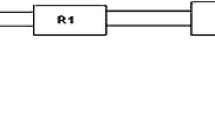Abstract
Achieving true random behavior in digital systems represents both a challenge and an opportunity for high-performance true random number generation (TRNG). Asynchronous cellular automata (ACA) are interesting candidates for reconfigurable hardware implementations, but one of its main problems is the identification of the best rules for performance and quality. In this article, we propose an analytical approach to evaluate and select suitable rules for TRNG with physical implementations of ACA networks. We introduce the concept of rule reactivity as an indicator of the expected ACA average transition rate. We also propose the concept of rule disequilibrium function for probabilistic estimation of the ACA output balance. Based on these analytic tools, it is possible to identify the best rules for ACA with any number of inputs.









Similar content being viewed by others
Data availability
The datasets generated during and/or analyzed during the current study are available from the corresponding author on reasonable request.
References
Mechalas, J.P.: Intel®Digital Random Number Generator (DRNG) Software Implementation Guide. Intel®(2018)
Communications in Nonlinear Science and Numerical Simulation 43, 139 (2017). https://doi.org/10.1016/j.cnsns.2016.05.002
Cicuttin, A., De Micco, L., Crespo, M., Antonelli, M., Garcia, L., Florian, W.: Physical implementation of asynchronous cellular automata networks: mathematical models and preliminary experimental results. Nonlinear Dyn. 105(3), 2431 (2021)
Ilachinski, A.: Cellular Automata: a Discrete Universe. World Scientific Publishing Company, Singapore (2001)
Dömösi, P., Nehaniv, C.L.: Algebraic Theory of Automata Networks: An Introduction. SIAM, New Delhi (2005)
Ping, P., Xu, F., Wang, Z.J.: In Generating high-quality random numbers by next nearest-neighbor cellular automata. Advanced Materials Research, vol. 765 (Trans Tech Publ, 2013), vol. 765, pp. 1200–1204
Tomassini, M., Sipper, M., Zolla, M., Perrenoud, M.: Generating high-quality random numbers in parallel by cellular automata. Futur. Gener. Comput. Syst. 16(2–3), 291 (1999)
Szaban, M., Seredynski, F., Bouvry, P.: Collective behavior of rules for cellular automata-based stream ciphers. In: 2006 IEEE International Conference on Evolutionary Computation. IEEE, pp. 179–183 (2006)
Seredynski, F., Bouvry, P., Zomaya, A.Y.: Cellular automata computations and secret key cryptography. Parallel Comput. 30(5–6), 753 (2004)
Bilan, S.: Pseudorandom Number Generators Based on Asynchronous Cellular Automata. IGI Global, Pennsylvania (2017)
Schönfisch, B., de Roos, A.: Synchronous and asynchronous updating in cellular automata. Biosystems 51(3), 123 (1999)
Fates, N., Thierry, É., Morvan, M., Schabanel, N.: Fully asynchronous behavior of double-quiescent elementary cellular automata. Theoret. Comput. Sci. 362(1–3), 1 (2006)
Fatès, N.: A tutorial on elementary cellular automata with fully asynchronous updating. Nat. Comput. 19(1), 179 (2020)
De Micco, L., Fernández, J.G., Larrondo, H.A., Plastino, A., Rosso, O.A.: Sampling period, statistical complexity, and chaotic attractors. Physica A 391(8), 2564 (2012)
Sloane, N.J.: et al. The on-line encyclopedia of integer sequences. OEIS Foundation Inc (2003). http://oeis.org
Wolfram MathWorld thue-morse sequence. https://mathworld.wolfram.com/Thue-MorseSequence.html. Accessed 02 Mar 2022
Wolfram, S.: Random sequence generation by cellular automata. Adv. Appl. Math. 7(2), 123 (1986)
Betel, H., de Oliveira, P.P., Flocchini, P.: On the parity problem in one-dimensional cellular automata. arXiv:1208.2758 (2012)
Acknowledgements
This work was partially supported by the ICTP Associates and STEP programs, the ICTP Multidisciplinary Laboratory, the CONICET (National Council for Science and Technology), the National Agency of Scientific and Technological Promotion (ANPCyT, PICT2019-03024) and the Department of Engineering and Architecture of the University of Trieste.
Funding
The authors have not disclosed any funding.
Author information
Authors and Affiliations
Corresponding author
Ethics declarations
Conflict of interest
The authors have no conflicts of interest to declare that are relevant to the content of this article.
Additional information
Publisher's Note
Springer Nature remains neutral with regard to jurisdictional claims in published maps and institutional affiliations.
Rights and permissions
Springer Nature or its licensor holds exclusive rights to this article under a publishing agreement with the author(s) or other rightsholder(s); author self-archiving of the accepted manuscript version of this article is solely governed by the terms of such publishing agreement and applicable law.
About this article
Cite this article
Cicuttin, A., De Micco, L., Crespo, M.L. et al. Looking for suitable rules for true random number generation with asynchronous cellular automata. Nonlinear Dyn 111, 2711–2722 (2023). https://doi.org/10.1007/s11071-022-07957-8
Received:
Accepted:
Published:
Issue Date:
DOI: https://doi.org/10.1007/s11071-022-07957-8




